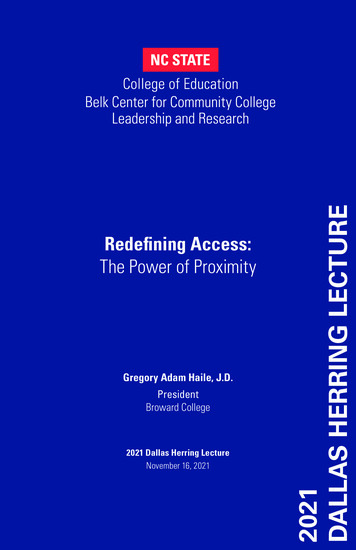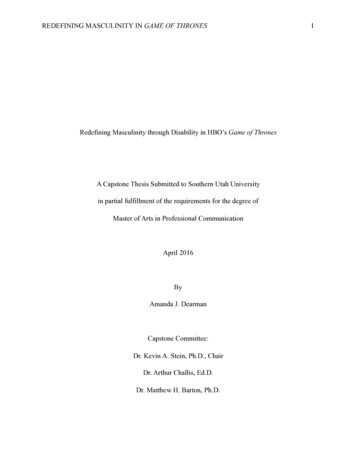
Transcription
Gregory Adam Haile, J.D.PresidentBroward College2021 Dallas Herring LectureNovember 16, 20212021DALLAS HERRING LECTURERedefining Access:The Power of Proximity
Dear Colleagues,We are pleased to share with you the full transcript of the 2021 Dallas Herring Lecture,delivered by Gregory Adam Haile, J.D., who serves as president of Broward College in Florida.This year’s lecture, held on Tuesday, November 16, 2021, was offered in a hybrid format, witha small group of invited attendees joining President Haile in person on NC State’s campus andmore than 800 others registering to participate virtually from across the nation. A signatureprogram of the Belk Center for Community College Leadership and Research in the College ofEducation at NC State University, this lecture is held annually in honor of W. Dallas Herring,whose transformative vision and tireless work culminated in the inception of North Carolina’scommunity colleges. Each year, exceptional community college leaders from around the countryare invited to speak on urgent and emerging topics, lending their voices and insight to thecritical conversations about student success taking place among community colleges across thestate and inspiring continued action and progress.In this year’s lecture, “Redefining Access: The Power of Proximity,” President Haile issuesa powerful call to action for community colleges to develop innovative approaches to beingproximate with the communities they are designed to serve. A critical step in ensuringequitable access to higher education, he argues, is understanding who colleges are reachingand who they are missing. Tracing the power of proximity back to our earliest years as learners,he describes how our future aspirations are inextricably linked to the information and signalswe receive — or don’t receive — about college and our postsecondary potential. Those inclose proximity to higher education are more likely to know it exists, recognize the value it canbring to their lives, understand the steps necessary to access it, and ultimately see it as anendeavor in which they belong and can be successful.President Haile reminds us that community colleges are, by design, uniquely positioned tobridge gaps in proximity, connecting students who might otherwise be missed with highereducation and the many benefits it has to offer. To do this, he calls upon colleges to addressproximity’s multiple dimensions: 1Physical proximity speaks to the importance of space and place in learning.Where are our students learning, and how are they getting there? What steps canwe take to minimize the physical distance between our students and our colleges?Social proximity involves how close members of our communities feel to ourinstitutions. Are we cultivating a sense of belonging among prospective studentslong before they arrive on our campuses? How might we engage more deeply withour communities to ensure our constituents understand what we offer and the waysour campuses can serve them?Financial proximity describes how members of our communities view the costs ofhigher education. How are we working to make college affordable for all students,and what are we doing to communicate that affordability to our communities?Beyond tuition, what expenses are students incurring, and what can we do to reducetheir financial burden?Belk Center for Community College Leadership and Research
In response to President Haile’s remarks, we were fortunate to benefit from the wisdom andinsight of three additional community college leaders, who discussed how their institutionsare working to address issues of proximity: Dr. Pamela Senegal, president of PiedmontCommunity College in North Carolina; Lee D. Lambert, J.D., chancellor of Pima CommunityCollege in Arizona; and Dr. Sunita “Sunny” Cooke, superintendent and president of MiraCostaCommunity College District in California.At an event in 1979, Dallas Herring said, “If I may use a Duplin County expression, we have toput the sawmill where the timber is or we are not going to saw very much lumber. We haveto take educational opportunities to the people, where they are, in the variety they need, at atime that is convenient to them and at a cost they can afford.” This is the very work PresidentHaile describes for us, work we are still seeking to accomplish to this day. Together withour community college partners, the Belk Center commits to being in closer proximity to ourstudents and communities — particularly those who have been historically and systematicallyunderserved by higher education — so, in the words of President Haile, “they will know weexist for them.”If you haven’t already, we encourage you to watch this year’s lecture, explore theaccompanying discussion guide, and share your thoughts and reactions with us online usingthe hashtag #DHL2021. We would like to thank Nohemi Ramirez, Monique Colclough, JaneWalters, and the entire Belk Center team for their contributions to this year’s lecture and thisbooklet, and we extend our deepest gratitude to our friends at the John M. Belk Endowmentfor their continued support of the Belk Center and North Carolina’s community colleges.Cordially,Audrey J. Jaeger, Ph.D.W. Dallas Herring ProfessorExecutive Director, Belk Center for CommunityCollege Leadership and Research2021 Dallas Herring Lecture by Gregory Adam Haile, J.D.Paola Sztajn, Ph.D.Professor of Mathematics EducationInterim Dean, College of Education2
About Gregory Adam Haile, J.D.Gregory Adam Haile, J.D., is the seventh president of Broward College. The institution, which servesapproximately 60,000 students annually, is part of the Florida College System and was named aTop Ten finalist for the prestigious Aspen Prize for the years 2013, 2017 (with distinction), 2019,and 2021 (with distinction). Since beginning his tenure as President in 2018, Broward College hassignificantly expanded its business model by offering educational opportunities, workforce training,and support services directly in neighborhoods throughout Broward County through an innovativeapproach called Broward UP .Haile has served in more than 40 board or committee capacities and in more than 20 chair orvice-chair capacities. He is immediate past chair of the board of Leadership Florida and serveson the boards of the Federal Reserve Bank of Atlanta, BBX Capital, Florida TaxWatch, EvergladesFoundation, the Florida Chamber, Pace Center for Girls, the Broward Workshop, the United Way ofBroward County, and the Greater Fort Lauderdale Alliance. He is also a member of the Orange BowlCommittee and the Council of Foreign Relations. He has twice received appointments by GovernorRon DeSantis: first, to the Department of Education Career and Technical Education AdvisoryCommittee, and second, to the Re-Open Florida Task Force. He has received dozens of recognitionsfor his leadership, service, and excellence in his profession and routinely serves as a keynotespeaker, primarily speaking on the transformational power of higher education. Haile was educatedat the Columbia University School of Law, where he was a Harlan Fiske Stone Scholar and servedas the editor-in-chief of the National Black Law Journal and as an editor of the Journal on Genderand Law. He received his bachelor’s degree from Arizona State University, where he graduatedmagna cum laude and received the Most Outstanding Graduate award in his college. He receivedan Honorary Doctorate of Humane Letters from Nova Southeastern University and is also a fellow ofthe Vanderbilt University Higher Education Management Institute.As an educator, Haile takes time annually to teach a self-designed 4-credit course in HigherEducation Law and Policy at Harvard University (Summer School).3Belk Center for Community College Leadership and Research
The 2021 Dallas Herring Lecture:Redefining Access:The Power of ProximityI am grateful for this opportunity to commemorate the work of Dr. W. Dallas Herring, avisionary chair of the North Carolina State Board of Education who changed the trajectoryof North Carolina and has left a great legacy upon which we can build. His work is alsoproof positive of how an intrinsic, yet innovative, idea can materially expand educationalaccess.I also want to commend the work undertaken by NC State‘s College of Education instrengthening this legacy. By bringing together community college leaders from acrossthe nation each year to discuss topics of critical importance to postsecondary education,you are facilitating conversations that might otherwise never happen. You have catalyzeddiscussions of the most pressing challenges facing our community colleges, and therebyour nation.The challenges before us require candid conversations, and I embrace such candor, forcandor and progress are inextricable. If we do not embrace the most painful truths, wehave decided to perpetuate them.Economic Disruption, Racial Reckoning, and the PandemicHeightened the Import of AccessThe need to improve postsecondary education access has always been critical to thework of community colleges, but we are at a crucial inflection point in our existence; aconvergence of crises facing our communities — economic disruption, racial reckoning,and the pandemic, each in varying states with varying life spans. Economic disruptioncomes and goes and is here again. The nation’s wound resulting from the murder ofGeorge Floyd is fresh and has spotlighted our nation’s long history of racial inequality.And, we continue to endure an ever-centennial pandemic. Independently, each of theaforementioned are heavy burdens. Together, they can be crushing.But, consider the implications of education attainment on this trio of troubles. First, whenthe economy faltered in 2020, those with less than a high school diploma experiencedemployment declines of 24%, those with a high school diploma experienced declinesof 16%, and those with some college saw declines of 10%. Yet, those with a bachelor’sdegree saw a mere 2% decline.1 Education attainment matters in economic downturns.1Rattner, S. (2020, July 16). Steven Rattner’s Morning Joe Charts: COVID-19’s Disproportionate Toll on Certain Workers (citingBureau of Labor toll-oncertain-workers/2021 Dallas Herring Lecture by Gregory Adam Haile, J.D.4
As to the second of the trio, regardless of race, income outcomes increase as educationalattainment increases. While equity gaps exist, the promise of improved economicoutcomes for all is powerful.As to the third of the trio, the pandemic, studies looking into death rates from COVID-19relative to education levels in the United States are still being conducted. However, aworking paper published by The Harvard Center for Population and Development Studies2examining COVID-19 death rates relative to education attainment provides an alarminginsight into who has borne the unequal burden of the virus. COVID-19 death rates weresubstantially elevated for persons without a college degree. Indeed, it appears educationattainment is at least intermingled with COVID-19 mortalities.Plainly, the work we do daily, and frankly, how well we do it, is measurably impactful tothe people we serve. Perhaps especially during our most dire times. Just as important,those whom we do not serve are impacted by our absence. Again, those whom we do notserve are impacted by our absence.My thesis is simple: Facing these truths, community colleges are obligated to developinnovative approaches to being proximate with the communities we are designed to serveto ensure equitable access to higher education.Allow me to contextualize my thesis by telling you a story. A young boy, a child, growsup in a violent urban neighborhood with no college graduates or attendees near or far tospeak of, or with. His parents understand the value of education, but they also realize thattheir home address prohibits them from sending their son to any school other than thelow-achieving elementary school in their neighborhood. So, as it goes, innovation is bornof despair and his mother lies about the family’s home address, which enables her son to2Chen, J.T., Testa, C., Waterman, P., & Krieger, N. (2021). Intersectional inequities in COVID-19 mortality by race/ethnicity and education in the United States, January 1, 2020–January 31, 2021. Harvard Center for Population andDevelopment Studies, ads/sites/1266/2021/02/21 Chen covidMortality RaceEducation HCPDS WorkingPaper Vol-21 No-3 Final footer.pdfEmployment Declines in 2020less than ahigh schooldiploma24%5high Belk Center for Community College Leadership and Research
attend an elementary school in another neighborhood whereshe believes he would be afforded a better education.“Most childrenare born with asmuch inherentpotential asanother. Per thesteady refrain,talent is evenlydistributed, butopportunityis not.”After all, the school is in a safer neighborhood and attendedby students from wealthier backgrounds. But here’s the catch— to access this better school, starting in the third grade, thisyoung boy must walk through dangerous housing projects byhimself, take a bus for 45 minutes, then walk a little more justto get to his elementary school.Fortuitously, while in the sixth grade, the young boy excitedlytells a classmate that they will be the last class of the decade,as they will graduate elementary school in 1989. The classmateresponds, “No, we are going to be the last class of themillennium because we are going to graduate college in 1999.”This young boy, taken aback, had just heard the word “college”for the first time. So here it is, a sixth grader, hearing aboutcollege for the first time from another sixth grader who knew precisely what year hewould graduate from college. Just as relevant, the boy in our story never forgets the firsttime he heard the word “college.”I compare his experience with that of taking my daughter, Hadley, to her first day of classin first grade in 2018. I walk up to the threshold of her classroom, and I look above thedoorway, and I see the name of a college above her classroom. I look to my right andthere are different college names above the doorways of each first grade classroom. Mydaughter, unlike this boy, will never start a day without seeing signals reminding her ofher college potential.That chasm should never exist — not for that little boy, not for your children, not for themost impoverished families, not for anyone. The difference in experiences between mydaughter and the sixth-grade boy illustrates the power of proximity. Most children areborn with as much inherent potential as another. Per the steady refrain, talent is evenlydistributed, but opportunity is not. Higher education is simply more proximate with mydaughter than it was with this sixth-grade boy.My daughters — Sloane, six, and Hadley, now 10 — already know a number of collegesthey want to attend simply because of where they live and go to school. Admittedly,having a college president as a father doesn’t hurt either. College will be present in theirlives every single day. And they will never remember the first time they heard the wordcollege — all a consequence of being proximate with college since the day they wereborn. It has nothing to do with their talent or their capacity, but the influence — thesignals and expectations that surround them.2021 Dallas Herring Lecture by Gregory Adam Haile, J.D.6
Community Colleges Are Charged to Remove Barriers and ProvideEasy Access.Back to the story of our young student. His mother is only able to perpetuate this falseaddress narrative until he completes middle school. His neighborhood is unsafe, riddledwith gun violence and drug abuse, and despite his mother’s attempt to find anotheraddress other than her own, he now must go to his neighborhood high school, whichmirrors his surrounding neighborhood.His high school has one of the highest HIV rates, highest teen pregnancy rates, and,because of the violence, it was in the first cohort of schools to require metal detectors toenter the building. Much like the metal detectors to get into his local movie theater, andthe bulletproof glass at the local convenience stores, and the bars on his home windows,he receives signals that danger is ever-present. Yet the notion of college never evenflickers.In fact, like most of his high school classmates, academic rigor and postsecondaryattainment are among the least of his interests, as survival strategies dominate histhinking. His disinterest is compounded by the math teacher who tells him in a room full ofother students that if he ever gets to college he will never survive.In any event, he graduates high school among the top 15% of his class, with a rathersomber 2.7 GPA. Notably, not a single college ever reached out to him. With so manydeterrents, so little proximity, what could ever lead him to believe he belonged in college?Proximity means more than just physical location — although location is crucial. Proximityalso must encompass the expectations and social connections a community might have toa collegiate institution.As many of you know, the prevalent view of the American community college as a local,public institution with a commitment and connection to the community it serves wasgalvanized nearly 75 years ago by the 1947 President’s Commission on Higher Education(Truman Commission). The Truman Commission produced a report entitled Higher Educationfor American Democracy and what stood out was the focus on equity in many respects:one’s background, family, and race. Let me share three quotes from the CommissionReport to add some context. In the first quote, note the reference to equality of educationopportunity, but also the concern of one’s birthplace dictating access to this opportunity:“One of the gravest challenges to which American society is subject is that of failingto provide a reasonable equality of education opportunity for its youth. For thegreat majority of our boys and girls, the kind and amount of education they may hopeto attain depends, not on their own abilities, but on the family or communityinto which they happened to be born or, worse still, on the color of their skin orthe religion of their parents.”7Belk Center for Community College Leadership and Research
In the second quote, note the explicit charge to community colleges regarding geographicproximity and ease of access:“Whatever form the community college takes, it will provide college education forthe youth of the community certainly, so as to remove geographic and economicbarriers to educational opportunity and discover and develop individual talents atlow cost and easy access.”For the third quote, it seems as if the commissioners were present here with us today — 75years later — focusing on the need to address barriers facing some of the most vulnerablemembers of our communities and busting the myth that a college education isn’t foreveryone:“The old, comfortable idea that ‘any boy can get a college education who has itin him’ simply is not true. Low family income, together with the rising costs ofeducation, constitutes an almost impassable barrier to college education formany young people. This economic factor explains in large part why the father’soccupation has been found in many studies to rank so high as a determining factorin a young person’s college expectancy. A farm laborer earns less than a banker ora doctor, for instance, and so is less able to afford the costs of higher education forhis children. The children, moreover, have less inducement to seek a collegeeducation because of their family background. In some social circles a collegeeducation is often considered a luxury which can be done without, somethingdesirable perhaps, ‘but not for the likes of us.’”Still today, so many are burdened with the belief, “not for the likes of us.”Community colleges were designed to enhance the proximity between postsecondaryeducation and our most challenged communities. This design was intentional. They aremeant to offer an equitable opportunity to secure degrees and vocational certificates,leading to increased lifetime earnings,3 better health outcomes,4 and decreased criminalactivity.5Mather, M., & Jarosz, B. (2014, November 17). Education in the U.S.: The Great Equalizer? Population Reference -education/C ollege Education Linked to Higher Pay, Job Security, Healthier Behaviors and More Civic Involvement: New College BoardReport. (2017, January 2). College Board Newsroom. s-and-more-civic-involvement-newCase, A., & Deaton, A. (2021). Life expectancy in adulthood is falling for those without a BA degree, but as educational gapshave widened, racial gaps have narrowed. Proceedings of the National Academy of Sciences, 118 (11). https://doi.org/10.1073/pnas.20247771185 B ell, B., Costa, R., & Machin, S. (2018, October 14). Why education reduces crime. VOX, CEPR Policy Portal. ime342021 Dallas Herring Lecture by Gregory Adam Haile, J.D.8
“Fifty years ago, the top quartile of income earners had about40% of their children graduating from college with a bachelor’sdegree, while the bottom quartile of income earners had about6% of their children graduating from college.Today, the top quartile of income earners has gone from 40%of their children graduating to 62%, while the bottom quartilehas gone from 6% of their children graduating fromcollege to only 13%.Said, perhaps, more dreadfully, the gap in bachelor’sattainment between the top quartile of income earners and thebottom quartile has grown from an already tragic 34%50 years ago to 49% today.”Colleges Must Account For Who We Are Serving and Who We AreMissingRemember that young boy from earlier? He went to college, but he is not guided bydreams of a college experience, or the lifelong benefits that will stem therefrom. Hesimply seeks to escape his neighborhood. Regretfully, he once asked his mother, “Whydo we have to live here?” He arrives at his college a few days before the start date,sight unseen, learns he needs remedial education, realizes he has no clue how to study,and ironically, finds discomfort in the absence of metal detectors on campus. Having noproximity or familiarity with his new environment, he is the all too common student whois not college ready, wondering if he belongs.We are obliged to bridge that chasm between talent and opportunity, and as one formerU.S. president noted, eliminate the soft bigotry of low expectations. So, to assesswhether we are fulfilling our obligation, a fundamental question must be addressed:Who are we missing? Despite the Commission Report, critical gaps remain in meetingour nearly 75-year-old charge.Fifty years ago, the top quartile of income earners had about 40% of their childrengraduating from college with a bachelor’s degree, while the bottom quartile of incomeearners had about 6% of their children graduating from college. Today, the top quartileof income earners has gone from 40% of their children graduating to 62%, while thebottom quartile has gone from 6% of their children graduating from college to only 13%.6Said, perhaps, more dreadfully, the gap in bachelor’s attainment between the top quartileof income earners and the bottom quartile has grown from an already tragic 34% 50years ago to 49% today. Even more, a Harvard Economics professor, Dr. Raj Chetty, has69The Hamilton Project. (2013, June). Thirteen Economic Facts about Social Mobility and the Role of oads/2016/06/thp 13econfacts final.pdfBelk Center for Community College Leadership and Research
“75% of students taking solely remote classesexpressed that staying engaged while learning onlinewas a major concern — even more than contractingCOVID-19 or getting a job after graduation.”produced profoundly powerful research indicating that the zip code that one grows up in ismost predictive of one’s income outcomes over one’s lifetime. 7While community colleges enrolled 41% of all undergraduates nationally in Fall 2019,8the unfortunate reality is that there are still many who we are not reaching. The pandemichas exacerbated the challenge. Community colleges lost nearly 10%, or 476,000, of theirstudents between Spring 2020 and Spring 2021.9 Researchers right here at North CarolinaState University found the need to work and financial constraints to be the prevailingchallenges responsible for enrollment declines.10As I mentioned before, the challenges are those of proximity. Allow me to expound uponthe three proximities we must address to equitably reach those we are designed to serve.The Three Proximities Imperative to Enhancing PostsecondaryAccessThe first is physical proximity. Even in 2021, education is geographically out of reachfor millions of Americans.Despite the advances in online learning and expedited use of remote learning during thepandemic, schools have prioritized the return to in-person learning because they know thevalue of educators and students being in the same room together.An October 2020 study by the Pew Research Center11 found that 68% of Americans didnot believe online classes provided the same value as in-person instruction. The NationalChetty, R., Hendren, N., Kline, P., & Saez, E. (June, 2014) Where is the Land of Opportunity? The Geography ofIntergenerational Mobility in the United Stateshttps://www.nber.org/papers/w198438American Association of Community Colleges. (2021). American Association of Community Colleges (AACC): Fast Facts 2021/03/AACC 2021 FastFacts.pdf9Current Term Enrollment Estimates. (2021, June 10). National Student Clearinghouse Research enrollment-estimates/10 Smith, A. (2019, February 12). What Community College Students Say Impedes Their Progress. Inside Higher -challenges11Parker, K., Barroso, A., & Fry, R. (2020, October 26). Americans are divided on whether colleges that brought students back tocampus made the right decision. Pew Research ecision/72021 Dallas Herring Lecture by Gregory Adam Haile, J.D.10
Association of Student Personnel Administrators12 reported that 75% of students takingsolely remote classes expressed that staying engaged while learning online was a majorconcern — even more than contracting COVID-19 or getting a job after graduation. Thesedata points exemplify the importance of space and place in learning and the value of thistype of proximity to the average student.Surely by now, we have all reflected upon anecdotal evidenceof students whose living arrangements do not provide asuitable learning environment; indeed, an appropriate spaceto learn is necessary for a student’s success.Another challenge is transportation. I once met a student whotold me that she walked four miles per day, each way, betweenher home and our college’s North Campus. She has the willof a giant. But for every one like her, we must presume thereare many reasonable people who desire more but will not orcannot walk four miles each way to get to a college campus.Of course, it is much more difficult for those in communitieswith no exposure to college, and even worse for those with abelief that they are inherently incapable of collegiate success.Per the Commission Report, “not for the likes of us.”“The individualsthat we aredesigned tosupport, thosewith fewtransportationoptions, thosewith the leastamount of time,those who areunfamiliar withour college,are the sameindividuals thatwe expect tocome to us.”The individuals that we are designed to support, those withfew transportation options, those with the least amount oftime — such as single parents with multiple jobs — thosewho are unfamiliar with our college or any college, are thesame individuals that we expect to come to us. This bearsrepeating. The individuals that we are designed to support, those with few transportationoptions, those with the least amount of time, those who are unfamiliar with our college,are the same individuals that we expect to come to us.The second of the three proximities is social. Social proximity is how proximate orclose members of the communities we serve feel to our institution.Building social proximity starts long before students get to our institutions. Communitycolleges tend to focus on socializing students once they arrive on our campuses. Weroutinely refer to this as a student’s sense of belonging. However, harkening back to mydaughters, they are eight and 12 years away from college, respectively, and they alreadyhave a sense of belonging. I mentioned their grade school experience. They have been onthe campuses of Broward College, Arizona State University, and Harvard University. We12Hess, A. J. (2021, July 29). As college students head back to class, some say benefits of online learning should not beforgotten. ndoned.html11Belk Center for Community College Leadership and Research
must create this sense of belonging long before the individuals arrive, for then it is too latefor an untold many. Of course, we can take grace in the fact that today, we are creating asense of belonging for 41% of higher education students across the nation, but we mustconsider how many never came to us due to a lack of belonging, due to a lack of socialproximity.“As educators,we have botha professionalduty and m
Gregory Adam Haile, J.D., is the seventh president of Broward College. The institution, which serves approximately 60,000 students annually, is part of the Florida College System and was named a . As an educator, Haile takes time annually to teach a self-designed 4-credit course in Higher Education Law and Policy at Harvard University (Summer .











